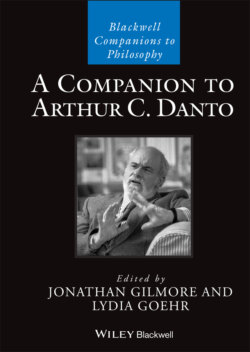Читать книгу A Companion to Arthur C. Danto - Группа авторов - Страница 41
1 Conceptual Issues about Art: Danto versus Wollheim
ОглавлениеA. Among the contributions for which Danto is known is his “Gallery of Indiscernibles.”1 It includes a set of imagined red canvases that cannot be distinguished from one another on perceptual grounds. This, presumably, is not due to the limits of perception but because they are identical with respect to perceptual properties. However, they have different descriptions, which include (1) a painting of people drowning in the Red Sea, (2) a landscape of Red Square, (3) a minimalist painting (perhaps “Homage to the Red Square” by Josef Albers), (4) a canvas stretched and painted red by Giorgione that he never used for a painting, (5) a stretched red canvas that “an egalitarian” artist finds and submits as art and which is accepted as such. There are other indiscernible items described by Danto outside this red canvas set that could inspire more red canvases, such as (6) a canvas painted red by a child, and (7) the product of a puff of red paint “miraculously” (and accidentally) forming another indiscernible canvas.
These imagined red canvases involve at least two representational artworks (1 and 2). These two canvases have different subjects but cannot be distinguished physically; they could be perceptually mistaken for one another. There are also artworks that could be mistaken for things that are not artworks (e.g., 1 and 4). These thought experiments could be raised as counterexamples to the claim that (a) different artworks must be perceptually distinguishable, and (b) artworks can be distinguished from non-artworks by perceivable properties (introduced by artists). If these general claims were shown to be false by the counterexamples, there would be at least some artworks that are not artworks because of their perceptual properties alone. Assuming we could create comparable indiscernibles with other perceptual properties that other artworks have (e.g., fuzzy blue halos), if the thought experiments were successful counterexamples to (a) and (b), they would show that perceptual properties are never sufficient to distinguish between what is an artwork and what is not.
B. Richard Wollheim has counterargued2 that something like (a) and (b) could be “general truths” rather than necessary truths. The general truths, he thinks, are that “objects … made with the broad intention of being works of art will stand out from objects … not made with such an intention and works of art … made with different specific intentions will stand out from one another” (p. 35). So the fact that (5) could be accepted as an artwork does not function as a counterexample to a necessary condition on art, and that a certain assumption can be transgressed in a particular case does not show it could be universally transgressed. In addition, (i) Wollheim suggests that it might not be possible to accept (5) as a work of art if the general truths he describes did not hold (which seems to imply that it is necessary that certain truths hold at least generally) and (ii) he claims it is important that we would only “reluctantly” (p. 34) accept this atypical item as an artwork.
Consider Wollheim’s claim about reluctance. Once the barrier is breached and one atypical item is recognized as art, it may become increasingly easy to recognize other atypical entities as works of art. This shows that one might have to distinguish the particular content of general truths from the suggestion that atypical works of art depend on works of art generally having the properties they lack. If many once-atypical items get admitted to the “artworld,” it may no longer be true that the same general truths hold, and while the formerly general truths may have been necessary at one point for the then-atypical item to be art, they will no longer be necessary for other items to be art (since the others may be judged relative to the “new normal”). I will later return to Wollheim’s views to ask how they relate to possible positions in ethics.
